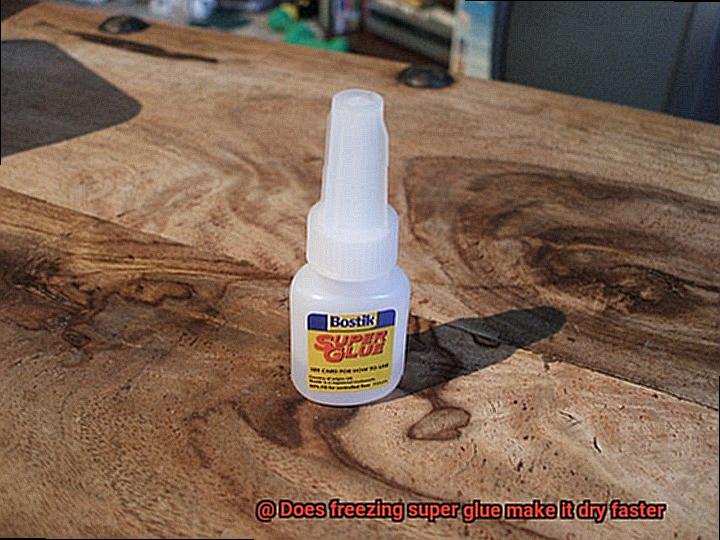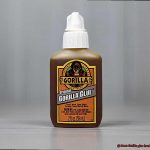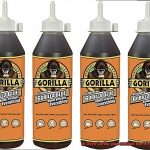When it comes to fixing things around the house or getting creative with DIY projects, super glue is often our trusty sidekick. Its unmatched strength and versatility make it a go-to adhesive for all sorts of tasks. But let’s face it, waiting for that glue to dry can be downright agonizing. Time is precious, my friend. So, here’s the burning question: does freezing super glue actually make it dry faster?
In our quest for knowledge, we’re about to embark on a mind-blowing scientific journey. We’ll dive headfirst into the fascinating world of temperature and its impact on the drying time of this legendary adhesive. By exploring how freezing affects super glue, we hope to separate fact from fiction in this age-old debate.
Join us as we unravel the mysteries behind the curing process of super glue, uncover the potential perks of freezing it, and determine whether this unconventional method truly accelerates drying time. Buckle up and get ready because we’re about to debunk myths and arm ourselves with solid evidence to unlock the secrets behind super glue’s ultimate drying efficiency. It’s time to dig into the icy depths of freezing super glue and discover the truth.
What is Super Glue?
Contents
In the world of adhesives, one name stands out for its exceptional strength and rapid bonding capabilities – Super Glue. Developed by Dr. Harry Coover Jr. during World War II, this remarkable adhesive has become a household staple for countless repair projects and DIY enthusiasts. So, what exactly is Super Glue, and how does it work its magic? Let’s delve into the science behind this bonding marvel.
The Composition of Super Glue:
Super Glue is a type of cyanoacrylate adhesive, derived from ethyl cyanoacrylate. This liquid compound is combined with stabilizers and thickeners to create the final product. With its low viscosity, Super Glue effortlessly penetrates tiny cracks and crevices, ensuring a strong bond.
The Power of Moisture:
When Super Glue encounters moisture, a fascinating chemical reaction called polymerization occurs. As the glue reacts with water molecules in the air, it rapidly solidifies and begins to form an unbreakable bond. This process releases heat, expediting drying time and ensuring quick adhesion.
Versatile Applications:
Super Glue’s versatility is one of its key advantages. It can bond various materials together seamlessly, whether it’s metal, plastic, rubber, ceramic, or wood. From everyday needs to specialized projects, this adhesive works wonders across a wide range of surfaces.
Unyielding Strength and Durability:

Once dried, Super Glue forms an incredibly strong bond that is difficult to break without causing damage to the materials being glued together. Its exceptional durability ensures a long-lasting hold that can withstand considerable stress and strain.
How Does Super Glue Work?
Get ready to unravel the science behind this extraordinary adhesive and discover why freezing it might not be the best idea. Don your lab coats and join us on this scientific adventure.
Chapter 1: The Marvelous Process of Polymerization
Super glue’s secret weapon lies in its ability to undergo a rapid chemical reaction known as polymerization. When this sticky superhero encounters moisture, it unleashes its powers. The molecules in super glue link together, forming long chains called polymers. Faster than a speeding bullet, the glue bonds surfaces almost instantly.
Chapter 2: The Ingredients that Give Super Glue its Strength
Our superhero’s main ingredient is cyanoacrylate, a liquid monomer containing carbon, oxygen, and nitrogen atoms. When moisture is present, these atoms form strong bonds with other atoms, creating an unyielding and durable adhesive. It’s like super glue has its own league of extraordinary atoms.
Chapter 3: Moisture – The Sidekick of Super Glue
Moisture plays a vital role in super glue’s performance. It kickstarts the polymerization process, enabling the adhesive to bond surfaces with lightning speed. However, too much moisture dampens our hero’s spirits. Excessive moisture dilutes the glue and prevents optimal contact between the adhesive and the surface. So remember, a little moisture goes a long way.
Chapter 4: The Chilling Effect of Freezing Super Glue
Chapter 5: Thawing Troubles
But wait, there’s more. Thawing frozen super glue can lead to further complications. The freezing and thawing process introduces moisture into the glue, triggering premature polymerization or weakening the adhesive bond. It’s like exposing our superhero to kryptonite – not a good idea.
Conclusion:
Super glue’s superpowers lie in its rapid polymerization process, triggered by moisture. Freezing super glue doesn’t speed up drying time; it hampers its bonding capabilities. To maintain our superhero’s effectiveness, store super glue at room temperature. So remember, when it comes to super glue, keep it cool but not frozen.
Does Freezing Super Glue Make it Dry Faster?
Super glue, the superhero of adhesives, possesses an astonishing ability to bond almost anything together in a matter of seconds. But does freezing this wonder adhesive accelerate its drying process? Let’s delve into the science behind it.
The drying process of super glue is a chemical reaction that occurs when the adhesive interacts with moisture in the air. However, freezing super glue does not expedite this process; instead, extreme temperatures have a chilling effect on our adhesive hero’s drying time.
When super glue is exposed to freezing temperatures, it becomes less reactive and takes longer to cure. The low temperature slows down the chemical reaction between the adhesive and moisture, thus delaying the drying process. So, if you’re seeking a speedy bond, avoid freezing your super glue.

Not only does freezing super glue decelerate its drying time, but it can also alter its consistency. The adhesive may thicken or become more viscous, impeding its even application and spread. This can be exasperating when striving for a precise bond.
Furthermore, freezing super glue can potentially compromise its bond strength. The extreme cold weakens the adhesive’s structural integrity, resulting in a less durable bond. Thus, for a robust and long-lasting bond, it is best to store and use super glue at room temperature.
Nevertheless, freezing super glue can come to the rescue in specific scenarios. For instance, if you inadvertently spill super glue on fabric or clothing, freezing it can prove advantageous. By placing the affected fabric in a freezer for several hours, the super glue becomes brittle. This allows for easier scraping without permanently bonding the fibers together.
In conclusion, while freezing super glue might offer some benefits in certain situations like removing spilled glue from fabric, it does not accelerate its drying time for regular bonding purposes. To ensure optimal bonding strength and efficiency, adhere to using super glue at room temperature and follow the manufacturer’s instructions.
Benefits of Freezing Super Glue
Today, we’re delving into the remarkable world of super glue and uncovering a little-known secret: freezing it can be incredibly beneficial. Prepare to have your mind blown. So grab your favorite adhesive, and let’s explore the myriad benefits of freezing super glue.
First and foremost, freezing super glue brings us the gift of extended shelf life. We all know that super glue can degrade over time, especially when exposed to heat or moisture. But fret not. Freezing super glue slows down those pesky chemical reactions that cause it to deteriorate. By keeping it fresh and ready for action for a longer period, freezing becomes the ticket to adhesive longevity. So if you’re not a frequent user or have a stockpile of glue waiting for its moment to shine, freezing is your saving grace.
But wait, there’s more. Freezing super glue also amplifies its bonding performance. As the glue chills, it becomes more viscous and thickens slightly. This change in consistency allows for a stronger bond on different surfaces. Whether you’re fixing a broken mug or crafting a masterpiece, freezing the glue beforehand ensures maximum strength and durability.
Precision is key, my friends. And freezing super glue makes it easier than ever to achieve that perfect application. No more dealing with runny glue that seems to have a mind of its own. When frozen, the glue becomes less flowy and more manageable to handle. This is particularly handy for delicate projects where precision is crucial.
Now, here’s a myth buster for you: freezing super glue doesn’t make it dry faster. In fact, it does the opposite. By chilling the glue, you’re actually slowing down the curing process. This gives you more time to position and adjust your glued parts before they fully dry. Talk about flexibility.
Last but certainly not least, versatility is the name of the game when it comes to frozen super glue. Need to stick something to a vertical surface without any dripping or running? Frozen super glue has your back. Looking for a temporary adhesive for assembly or repair work? Frozen super glue remains tacky and repositionable for longer. It’s like the MacGyver of adhesives.
Drawbacks of Freezing Super Glue
Prepare to be amazed as we embark on a journey into the extraordinary realm of super glue and uncover a little-known secret: freezing it can extend its shelf life, amplify bonding performance, enhance precision, and provide unparalleled versatility. Frozen super glue is the MacGyver of adhesives. However, before you race to your freezer in excitement, let’s examine the drawbacks of freezing super glue.
Decreased Effectiveness:
The chemical properties of super glue undergo changes when frozen, negatively impacting its effectiveness. The formation of ice crystals from frozen water molecules disrupts the bonding process, resulting in weakened adhesion and slower drying times upon thawing.
Increased Brittleness:
Extreme cold temperatures render frozen super glue more susceptible to cracking and breaking. This compromise weakens the strength and durability of the bond created by the glue. Picture delicately glued pieces disintegrating due to brittleness.
Reduced Shelf Life:
Super glue already has a limited shelf life, and freezing it further diminishes its effectiveness over time. Freezing degrades the adhesive properties, reducing stickiness and reliability. So, relying on your frozen stash for long-term projects is not advisable.
Inconsistent Results:
Freezing and thawing super glue introduces inconsistencies in its adhesive consistency. Achieving a consistent and reliable bond becomes challenging when temperature fluctuations alter the glue’s properties. Inconsistency is not desirable when relying on super glue for important projects.
Inconvenience and Safety Risks:
Freezing super glue necessitates additional steps and precautions that may not always be practical or efficient for users. Incorrect freezing or thawing can render the glue unusable or affect its performance. Handling frozen super glue poses risks, as it becomes harder and more brittle, increasing the chances of shattering and causing injuries.
Best Practices for Storing Super Glue
Whether you’re a crafting connoisseur or a DIY diva, proper storage of super glue is essential to maximize its effectiveness and shelf life. So, let’s dive right in and discover the best practices that will revolutionize your glue game.
First and foremost, let’s talk about location, because it’s not just important in real estate. Super glue prefers a cool and dry environment, so keep it away from moisture-prone areas like bathrooms or basements. We don’t want our glue prematurely curing or losing its effectiveness, do we? And extreme temperatures are a big no-no. Aim for room temperature storage between 50°F and 77°F (10°C – 25°C) to ensure optimal performance. Trust me, your glue will thank you with stronger bonds.
Now let’s seal the deal (literally). After each use, make sure to tightly close the nozzle or cap on your super glue bottle. Air exposure can cause the glue to harden inside the container, turning it into a sad, unusable blob. But fear not. By sealing it tight, you’re keeping your glue fresh and ready for action when you need it most.
Speaking of action, let’s prevent any unwanted spills or leaks. Storing your super glue upright is the way to go. This simple step can save you from sticky situations and keep your workspace clean and organized. And if you want an extra layer of protection, consider placing the bottle in a secure container or drawer. Safety first, my friends.
Now here’s a pro tip: always check the expiration date before using your super glue. Just like milk, it has a shelf life too. Depending on the brand, expect anywhere from 6 months to a year of bonding bliss. Using expired glue can lead to weaker bonds and disappointment in your projects. So stay fresh and fabulous by keeping an eye on that expiration date.
Last but certainly not least, let’s keep our glue out of reach from curious little hands and paws. Super glue may work wonders on materials, but it’s not meant for skin or ingestion. Storing it in a safe and secure location will give you peace of mind and ensure the longevity of your adhesive companion.
Alternatives to Freezing Super Glue
There are alternatives to freezing super glue that can have your projects sticking together in no time. Let’s explore some other drying accelerators that are just as effective.
First up, we have the power of heat. By applying a little warmth to the glued area, you can kickstart the curing process. Try using a hairdryer on a low heat setting or place your glued object into a low-temperature oven. But remember, don’t go overboard with the heat as it can cause the glue to lose its adhesive properties or damage certain materials.
If heat isn’t your thing, fear not. There are accelerators and activators specially designed for super glue. These magical products are applied to one of the surfaces being bonded before adding the glue. They work wonders by promoting faster curing. Accelerators are particularly useful for porous materials or in chilly temperatures where freezing may not be feasible.
Next, we have the secret weapon of pressure. By exerting force on the glued surfaces, you not only create a stronger bond but also encourage faster curing. Get your clamps, weights, or just use your own hands to firmly hold the surfaces together for a few minutes.
Now, here’s an out-of-the-box idea: why not consider using a different type of adhesive? Instant adhesives, also known as cyanoacrylate-based adhesives, offer similar properties to super glue but often have faster curing times. So if speed is what you seek, give these alternatives a try.
Last but not least, let’s not underestimate the power of proper application techniques. Taking a few extra steps like ensuring both surfaces are clean and dry before applying the super glue and spreading a thin, even layer can go a long way in speeding up the drying process.
3oQMFWFbOw8″ >
Also Read: Why Doesn’t Glue Stick to The Inside of The Bottle?
Conclusion
In conclusion, freezing super glue does not expedite the drying process. In reality, freezing can actually impede the adhesive’s ability to dry and weaken its bond strength. Super glue relies on a swift chemical reaction with airborne moisture to solidify rapidly and create a robust bond. However, freezing slows down this reaction, making it challenging for the adhesive to cure effectively.
Moreover, freezing super glue can alter its consistency, thickening it and increasing its viscosity. This alteration hampers its application and spreadability, making it more difficult to achieve precise bonding.
Although there are some advantages to freezing super glue, such as prolonging its shelf life and enhancing bonding performance in specific situations, these benefits may not outweigh the drawbacks. Freezing can diminish the adhesive’s effectiveness, increase brittleness, shorten shelf life, yield inconsistent results, and even pose safety risks.
To ensure optimal bonding strength and efficiency, it is crucial to store and use super glue at room temperature. Adhering to proper storage practices such as tightly sealing the bottle after each use and storing it upright in a cool and dry location will help maintain its effectiveness.
If you’re seeking alternatives to accelerate the drying time of super glue, consider utilizing heat or specialized accelerators/activators designed for cyanoacrylate-based adhesives. Applying pressure during bonding or exploring other instant adhesive options with faster curing times are also viable alternatives.






